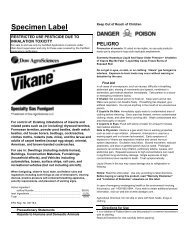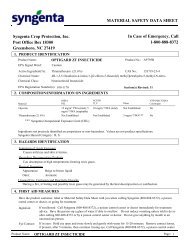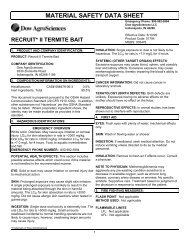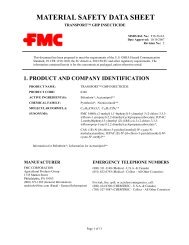Premise ® 2 Insecticide - Label
Premise ® 2 Insecticide - Label
Premise ® 2 Insecticide - Label
Create successful ePaper yourself
Turn your PDF publications into a flip-book with our unique Google optimized e-Paper software.
<strong>Premise</strong> ® 2<strong>Insecticide</strong>For use by individuals/firms licensed or registered by the state to apply termiticide products. States may have morerestrictive requirements regarding qualifications of persons using this product. Consult the structural pest control regulatoryagency of your state prior to use of this product.For prevention or control of subterranean termites, drywood termites, dampwood termites, carpenter ants, and other woodinfestinginsects.ACTIVE INGREDIENT:Imidacloprid,1-[(6-Chloro-3-pyridinyl)methyl]-N-nitro-2-imidazolidinimine ..................................................................................... 21.4%INERT INGREDIENTS:.................................................................................................................................................................... 78.6%Total: 100.0%Contains 2 pounds of imidacloprid per gallon.Shake well before using.EPA Reg. No. 432-1331Stop - Read the label before use.Keep out of reach of children.CAUTIONEPA Est. No. 11556-KS-1, 3125-MO-1, 264-MO-2, 432-TX-1PRECAUCION AL USUARIO: Si usted no puede leer o entender inglés, no use este producto hasta que la etiqueta le haya sidoexplicada ampliamente.(TO THE USER: If you cannot read or understand English, do not use this product until the label has been fully explained to you.)PRECAUTIONARY STATEMENTSHAZARDS TO HUMANS AND DOMESTIC ANIMALSCAUTION: Harmful if swallowed, inhaled, or absorbed through skin. Avoid contact with skin, eyes, or clothing. Wash thoroughly withsoap and water after handling. Remove contaminated clothing and wash before reuse. Keep children or pets away from treated areauntil dry.When treating adjacent to an existing structure, the applicator must check the area to be treated, and immediately adjacent areas of thestructure, for visible and accessible cracks and holes to prevent any leaks or significant exposures to persons occupying the structure.People present or residing in the structure during application must be advised to remove their pets and themselves from the structure ifthey see any signs of leakage. After application, the applicator is required to check for leaks. All leaks resulting in the deposition oftermiticide in locations other than those prescribed on this label must be cleaned up prior to leaving the application site. Do not allowpeople or pets to contact contaminated areas or to reoccupy contaminated areas of the structure until the clean up is completed.Personal Protective EquipmentAll pesticide handlers (mixers, loaders, and applicators) must wear long-sleeved shirt and long pants, socks, shoes, and chemicalresistantgloves made of waterproof material such as barrier laminate, butyl rubber, nitrile rubber, neoprene rubber, polyethylene,polyvinyl chloride or viton. After the product is diluted in accordance with label directions for use, shirt, pants, socks, shoes must beworn. In addition: all pesticide handlers must wear protective eyewear when working in a non-ventilated space or when applyingtermiticide by rodding or sub-slab injection.1
FIRST AIDIf Swallowed • Call a poison control center or doctor immediately for treatment advice.• Have person sip a glass of water if able to swallow.• Do not induce vomiting unless told to do so by a poison control center or doctor.• Do not give anything by mouth to an unconscious person.If on Skin or Clothing • Take off contaminated clothing• Rinse skin immediately with plenty of soap and water for 15 to 20 minutes.• Call a poison control center or doctor for treatment advice.If in Eyes • Hold eyelids open and rinse slowly and gently with water for 15 to 20 minutes.• Remove contact lenses, if present, after the first 5 minutes, then continue rinsing eye.• Call a poison control center or doctor for treatment advice.HOT LINE NUMBERHave the product container or label with you when calling a poison control center or doctor, or going for treatment. You may alsocontact 1-800-334-7577 for emergency medical treatment.No specific antidote is available. Treat patient symptomatically.NOTE TO PHYSICIANENVIRONMENTAL HAZARDSThis product is highly toxic to aquatic invertebrates. Do not apply directly to water, to areas where surface water is present or tointertidal areas below the mean high water mark. Do not contaminate water when disposing of equipment washwaters. Apply thisproduct only as specified on this label. Extreme care must be taken to avoid runoff. Apply only to soil or other fill substrate that willaccept the solution at the specified rate. Do not treat soil that is water-saturated or frozen or in any conditions where run-off ormovement from the treatment area (site) is likely to occur.DIRECTIONS FOR USEIt is a violation of Federal law to use this product in a manner inconsistent with its labeling.Structures that contain wells or cisterns within the foundation of the structure can only be treated using the treated backfill methoddescribed in the treatment around wells and cisterns section of this label. Consult state and local specifications for recommendeddistances of wells from treated area, or if such regulations do not exist, refer to Federal Housing Administration Specifications (H.U.D.)for guidance.Do not formulate this product into other end-use products.MIXING: Refer to Mixing Table for proper amount of PREMISE 2 <strong>Insecticide</strong> to be used.Mix the termiticide use dilution in the following manner. Fill tank ¼ to 1/3 full. If using large sprayer, start pump to begin bypassagitation and place end of treating tool in tank to allow circulation through hose. Add appropriate amount of PREMISE 2 <strong>Insecticide</strong>.Add remaining amount of water. Let pump run and allow recirculation through the hose for 2 to 3 minutes.MIXING TABLE FOR PREMISE 2 INSECTICIDEGALLONS WATER 0.05% 0.1%10 80 mL 160 mL5 PLUS40 mL 80 mL2 16 mL 32 mL18 mL 16 mLMIXING TABLE FOR PREMISE 2 INSECTICIDEGALLONS WATER 0.05% 0.1%100 27.5 fl oz 55.0 fl oz50 PLUS13.8 fl oz 27.5 fl oz25 6.9 fl oz 13.8 fl oz10.3 fl oz 0.6 fl oz[FOR 240 mL SIZE ONLY]*[FOR 55 FL OZ SIZE ONLY]**Contingent on container size, only one or the other of the tables will be used.2
PROPORTIONAL INJECTOR MIXING TABLE FOR PREMISE 2 INSECTICIDEINJECTOR VOLUME (fl oz/gal) CONCENTRATION (%)0.3 0.050.6 0.10IN-LINE-INJECTION: For the desired application rate, use the proportional injector mixing table to determine the amount of PREMISE2 <strong>Insecticide</strong> for a given injection volume of finished emulsion.CONVERSION KEY: 128 fl oz = 1 gal, 16 fl oz= 1 pint, 8 pints = 1 gal, 1 fl oz = 29.5 mLAPPLICATION VOLUMEIt is recommended that application volumes described in the PREMISE 2 <strong>Insecticide</strong> "DIRECTIONS FOR USE" be used wheneverpossible. However, where soil conditions will not accept application of 4 gallons of PREMISE 2 <strong>Insecticide</strong> per 10 linear feet, twice thePREMISE 2 <strong>Insecticide</strong> concentration may be applied in 2 gallons of solution per 10 linear feet. For example, if 0.05% is the correctuse rate to be applied in 4 gallons of water, then 2 gallons of 0.1% dilution may be used per 10 linear feet to deliver an equivalentamount of PREMISE 2 <strong>Insecticide</strong> per unit of soil.CONTROL - GENERALTreatment standards for subterranean termite control may vary due to regulations, treatment procedures, soil types, constructionpractices and other factors. The purpose of chemical soil treatment for termite control is to establish a continuous chemical treatedzone (horizontal and/or vertical as needed) between the wood and other cellulose material in the structure and the termite colonies inthe soil. Follow all federal, state, and local regulations and treatment standards for protection of a structure from termites. In someinstances where an aerial or above ground colony is established, supplemental treatments to control the termites, landscapemodifications, and/or structural repairs may be needed to deprive termites of a moisture source. Use a 0.05% to 0.1% dilution basedon local recommendations. Generally a 0.05% dilution is used for typical control situations. Where severe or persistent infestationsoccur, a 0.1% dilution may be used.PRE-CONSTRUCTION TREATMENTDo not apply at a lower dosage and/or concentration than specified on this label for application prior to installation of the finished grade.Prior to each application, applicators must notify the general contractor, construction superintendent, or similar responsible party, of theintended termiticide application and intended sites of application and instruct the responsible person to notify construction workers andother individuals to leave the area to be treated during application and until the termiticide is absorbed into the soil.CONCRETE SLAB-ON-GROUND OR BASEMENTS: Apply an overall treatment to the entire surface of soil or other substrate to becovered by the slab including areas to be under carports, porches, basement floor and entrance platforms. Apply at the rate of 1 gallonof solution to accurately and uniformly cover 10 square feet. If fill under slab is gravel or other coarse aggregate, apply at the rate of1.5 gallons or sufficient volume of solution, to accurately and uniformly cover 10 square feet. In addition, apply 4 gallons of solution(see APPLICATION VOLUME) per 10 linear feet to provide a uniform treated zone in soil at critical areas such as along the inside offoundation walls, and around plumbing, bath traps, utility services, and other features that will penetrate the slab.After completion of grading, make an application by trenching or trenching and rodding around the slab or foundation perimeter.Rodding may be done from the bottom of a shallow trench. When rodding, rod holes must be spaced in a manner that will allow for acontinuous chemical treated zone, not to exceed 12 inches, to be deposited along the treated area. Rod holes should not extend belowthe footing. Apply 4 gallons of solution (see APPLICATION VOLUME) per 10 linear feet, per foot of depth to provide a uniform treatedzone. When trenching, the trench along the outside foundation should be about 6 inches in width and 6 inches in depth. Use a lowpressure spray (not to exceed 25 PSI at the treatment tool when the valve is open) to treat soil which will be placed in the trench afterrodding. Mix the spray solution with soil as it is being placed in the trench. When treating voids in hollow masonry units, use 2 gallonsof solution per 10 linear feet of wall. Apply solution so it will reach the footing by injecting into the lower areas of the wall, just above thefloor or footing.When treating foundations deeper than 4 feet, apply the termiticide as the backfill is being replaced, or if the construction contractorfails to notify the applicator to permit this, treat the foundation to a minimum depth of 4 feet after the backfill has been installed. Theapplicator must trench and rod into the trench or trench along the foundation walls and around pillars and other foundation elements, atthe rate prescribed from grade to a minimum depth of 4 feet. When the top of the footing is exposed, the applicator must treat the soiladjacent to the footing to a depth not to exceed the bottom of the footing. However, in no case should a structure be treated below thefooting.Rodding in trench followed by flooding of trench and treatment of backfill may provide a better opportunity to achieve a continuouschemical treated zone than using soil rodding alone to establish a vertical termiticide treated zone.CRAWL SPACES: Application must be made by trenching or trenching and rodding downward along the inside and outside offoundation walls, around piers, interior supports in contact with the soil, plumbing, and utility services. Apply 4 gallons of solution (seeAPPLICATION VOLUME) per 10 linear feet, per foot of depth to provide a uniform treated zone. Rodding may be done from the bottomof a shallow trench to top of the footing or a minimum of 4 feet. When rodding, rod holes must be spaced in a manner that will allow fora continuous chemical treated zone to be deposited along the treated area. Rod holes should not extend below the footing. Whentrenching, the trench should be about 6 inches wide and 6 inches deep. Use a low pressure spray to treat soil which will be placed inthe trench, mixing the spray solution with soil as it is being placed in the trench.3
HOLLOW BLOCK FOUNDATIONS OR VOIDS: Hollow block foundations or voids in masonry resting on the footing may be treated toprovide a continuous chemical treated zone in the voids at the footing. Apply 2 gallons of solution per 10 linear feet to the lower part ofthe void so that it reaches the top of the footing or soil.Treatment of voids in block or rubble foundation walls must be closely examined. Applicators must inspect areas of possible runoff as aprecaution against application leakage in the treated areas. Some areas may not be treatable or may require mechanical alterationprior to treatment.All leaks resulting in the deposition of termiticide in locations other than those prescribed on this label must be cleaned up prior toleaving the application site (refer to Precautionary Statements). Do not allow people or pets to contact or to reoccupy the contaminatedareas of the structure until the clean up is completed.POST-CONSTRUCTION TREATMENTCONCRETE SLAB-ON-GROUND: To apply a treatment under the slab, including attached porches, carports, entrance platforms,garages and similar slab structures, it may be necessary to drill through the slab or exterior foundation. Drill holes should be spaced ina manner that will allow for application of a continuous chemical treated zone. Treat all existing cracks and cold, construction orexpansion joints. Also, treat around bath traps, plumbing and utility services which penetrate the slab. Apply 4 gallons of solution (seeAPPLICATION VOLUME) per 10 linear feet per foot of depth to provide a uniform treated zone. DO NOT MAKE TREATMENT UNTILLOCATION OF HEAT OR AIR CONDITIONING DUCTS AND VENTS ARE KNOWN AND IDENTIFIED. USE EXTREME CAUTION TOAVOID CONTAMINATION OF DUCTS AND VENTS. Plug and fill all drilled holes in commonly occupied areas with a suitable sealant.Plugs must be of non-cellulose material or covered by an impervious, non-cellulose material.An application should be made by trenching or trenching and rodding around the outside of the foundation wall. Apply 4 gallons ofsolution (see APPLICATION VOLUME) per 10 linear feet per foot of depth to provide a uniform treated zone. When trenching, thetrench along the outside foundation should be about 6 inches wide and 6 inches deep. Use a low pressure spray to treat soil as it isbeing placed in the trench.Rodding can be done from the bottom of a shallow trench. When rodding, rod holes should be spaced in a manner that will allow for acontinuous chemical treated zone, not to exceed 12 inches, to be deposited along the treated area. Rod hole depth should not extendbelow the footing.BATH TRAPS: Exposed soil or soil covered with tar or a similar type sealant beneath and around plumbing and/or drain pipe entryareas should be treated with 3 gallons of solution per square foot. An access door or inspection vent should be cut and installed, if notalready present. After inspection and removal of any wood or cellulose debris, the soil can be treated by rodding or drenching the soil.CRAWL SPACES: When there is insufficient clearance between floor joists and ground surfaces to allow applicator access, excavate,if possible, and treat according to crawl spaces (refer to Pre-Construction Treatment). If unable to excavate, crawl space soil and woodtreatment may be used to prevent surface access by termites. Apply 1 gallon of solution (see APPLICATION VOLUME) per 10 squarefeet to provide a uniform chemical treated zone. Use a very coarse spray at a pressure not exceeding 25 PSI at the treatment toolwhen the valve is open.Where a crawl space cannot be reached with the application wand, use extension wands or other suitable equipment to apply a coarsespray on the soil, wood and structural members contacting the soil at the above rates. Do not apply to inaccessible crawl space areasusing pressures greater than 25 PSI at the treatment tool when the valve is open.Treatment may also be made by drilling through the foundation wall or through the floor above and treating the soil perimeter at a rateof 1 gallon of solution per 10 square feet. Drill spacing must be at intervals not to exceed 16 inches. Many states have smallerintervals so check state regulations which may apply.To prevent subterranean termites from constructing mudtubes between soil and crawl space wood members above, an overall soiltreatment of this product may be applied. Remove all cellulose debris before application. Apply 1 gallon of solution (seeAPPLICATION VOLUME) per 10 square feet to provide a uniform chemical treated zone.SHALLOW FOUNDATIONS: For shallow foundations, one foot or less in depth, dig a narrow trench approximately 6 inches wide anddeep along the outside and inside of the foundation walls, being careful not to dig below the bottom of the footings. For foundationswith exposed footings, dig a trench alongside the footing taking care not to undermine the footing. Apply 4 gallons of solution (seeAPPLICATION VOLUME) per 10 linear feet to the top of footer to provide a uniform treated zone. The dilution should be applied to thetrench and mixed with the soil as it is placed in the trench.BASEMENTS - OUTSIDE PERIMETER: Along the outside of the exterior walls, an application must be made by trenching or roddingwithin the trench. Rodding depth should be to the top of the footer, or to a minimum of 4 feet or according to state or local regulations.When rodding through a trench, dig a narrow trench about 6 inches wide and 6 inches deep. Apply 4 gallons of solution (seeAPPLICATION VOLUME) per 10 linear feet, per foot of depth to provide a uniform treated zone by rodding through the trench. Use alow pressure spray to treat soil which will be placed into the trench after rodding. Mix spray solution with the soil as it is being placed inthe trench.BASEMENTS - INSIDE PERIMETER: If necessary, treat by drilling along the perimeter of the interior walls. Applications also may benecessary around sewer pipes, floor drains, conduits, expansion joints or any cracks or holes in the basement floor. Apply 4 gallons ofsolution (see APPLICATION VOLUME) per 10 linear feet to provide a uniform treated zone.Drill holes should be spaced in a manner that will allow for application of a continuous chemical treated zone. Plug and fill all drill holesin commonly occupied areas of the building with a suitable sealant. Plugs must be of non-cellulose material or covered by animpervious, non-cellulose material.HOLLOW BLOCK FOUNDATION OR VOIDS: Hollow block foundations or voids in masonry resting on the footing may be treated toprovide a continuous chemical treated zone in the voids at the footing. Apply 2 gallons of solution per 10 linear feet to the lower part ofthe void so that it reaches the top of the footing or soil. Drill spacing must be at intervals not to exceed 16 inches. Many states havesmaller intervals so check state regulations which may apply.4
Treatment of voids in block or rubble foundation walls must be closely examined. Applicators must inspect areas of possible runoff as aprecaution against application leakage in the treated areas. Some areas may not be treatable or may require mechanical alterationprior to treatment.All leaks resulting in the deposition of termiticide in locations other than those prescribed on this label must be cleaned up prior toleaving the application site (refer to Precautionary Statements). Do not allow people or pets to contact or to reoccupy the contaminatedareas of the structure until the clean up is completed.PLENUMS: For plenum-type structures which use a sealed underfloor space to circulate heated and/or cooled air throughout thestructure, apply the dilution at the rate of 4 gallons of solution (see APPLICATION VOLUME) per 10 linear feet, per foot of depth of soilto provide a uniform treated zone adjacent to both sides of foundation walls, supporting piers, plumbing and conduits. The soil shouldbe treated by trenching to a depth of 6 inches or trenching and rodding (where conditions permit) or to the top of the footing. Whenconditions will not permit trenching or rodding, a surface application adjacent to interior foundation walls may be made, but the treatedstrip shall not exceed a width of 18 inches, horizontally, from the foundation walls, piers or pipes. The surface application will be madeat a rate of 1.5 gallons of solution per 10 square feet as a very coarse spray under low pressure (not to exceed 25 PSI when measuredat the treating tool when valve is on).When treating plenums, turn off the air circulation system of the structure until application has been completed and all termiticide hasbeen absorbed by the soil.TREATMENT AROUND WELLS OR CISTERNS: Do not contaminate wells or cisterns.Structures With Wells/Cisterns Inside Foundations: Structures that contain wells or cisterns within the foundation of a structure canonly be treated using the following techniques:1. Do not apply within 5 feet of any well or cistern by rodding and/or trenching or by the backfill method. Treat soil between 5 and 10feet from the well or cistern by the backfill method only. Treatment of soil adjacent to water pipes within 3 feet of grade should onlybe done by the backfill method.a) Trench and remove soil to be treated onto heavy plastic sheeting or similar material or into a wheelbarrow.b) Treat the soil at the rate of 4 gallons of solution per 10 linear feet per foot of depth of the trench, or 1 gallon per 1.0 cubic feetof soil. Mix thoroughly into the soil taking care to contain the liquid and prevent runoff or spillage.c) After the treated soil has absorbed the solution, replace the soil into the trench.2. Treat infested and/or damaged wood in place using an injection technique such as described in the “Control of Wood InfestingPests” section of this label.Structures With Adjacent Wells / Cisterns and/or Other Water Bodies: Applicators must inspect all structures with nearby watersources such as wells, cisterns, surface ponds, streams, and other bodies of water and evaluate, at a minimum, the treatmentrecommendations listed below prior to making an application.1. Prior to treatment, if feasible, expose the water pipe(s) coming from the well to the structure, if the pipe(s) enter the structure within3 feet of grade.2. Prior to treatment applicators are advised to take precautions to limit the risk of applying the termiticide into subsurface drains thatcould empty into any bodies of water. These precautions include evaluating whether application of the termiticide to the top of thefooter may result in contamination of the subsurface drain. Factors such as depth to the drain system and soil type and degree ofcompaction should be taken into account in determining the depth of treatment.3. When appropriate (i.e., on the water side of the structure), the treated backfill technique (described above) can also be used tominimize off-site movement of termiticide.5
FOAM APPLICATIONSConstruction practices, soil subsidence and other factors may create situations in which a continuous chemical treated zone cannot beachieved using conventional treatment alone. In situations where necessary, conventional application methods can be supplementedthrough use of foam generating equipment, or similar devices, to provide a continuous treated zone.*Contingent on container size, only one or the other of the other of the tables will be used.Foam application may be made alone or in combination with conventional application methods, provided that the labeled amount ofactive ingredient per unit area is used.Foam Application Use Directions: Mix appropriate concentration of PREMISE® 2 <strong>Insecticide</strong> in water and add the manufacturer’srecommended quantity of foam agent to the PREMISE® 2 INSECTICIDE solution (see table for foaming recommendations). Apply asufficient volume of PREMISE® 2 <strong>Insecticide</strong> foam alone or in combination with liquid solution to provide a continuous treated zone atthe recommended rate for specific application sites.[FOR 240 ML SIZE ONLY]*MIXING TABLE FOR PREMISE® 2 INSECTICIDE FOAMPREMISE 2 b (mL) GALLONS OF WATER FOAM EXPANSIONFINISHED FOAMRATIO(gallons)160 1 20:1 2080 1 10:1 1040 1 5:1 5* Add the manufacturer’s recommended quantity of foam agent to the PREMISE® 2 <strong>Insecticide</strong> solution(ai%)0.05[FOR 55 FL OZ SIZE ONLY]*MIXING TABLE FOR PREMISE® 2 INSECTICIDE FOAMPREMISE® 2 b (fl oz)FOAM EXPANSIONFINISHED FOAMGALLONS OF WATERRATIO (gallons) (ai%)6.91 25:12.5 10:1255 5:113.81 50:12.5 20:1505 10:1* Add the manufacturer’s recommended quantity of foam agent to the PREMISE® 2 <strong>Insecticide</strong> solution0.05Depending on the circumstances, foam applications may be used alone or in combination with liquid solution applications. Applicationsmay be made behind veneers, piers, chimney bases, into rubble foundations, into block voids or structural voids, wall voids, underslabs, stoops, porches, or to the soil in crawlspaces, and other similar voids.Foam and liquid applications must be consistent with volume and active ingredient instructions in order to ensure properapplication has been made. The volume and amount of active ingredient are essential to an effective treatment. At least 75%of the gallons of <strong>Premise</strong>® 2 must be applied as a typical liquid treatment. The remaining 25% or less gallons is delivered toappropriate locations using a foam application.NOTE: When foam is used solely to kill subterranean termites in above ground locations (such as feeding galleries in wooden framing,or in voids with framed walls), and whenever the target pest is other than subterranean termites (drywood termites, beetles, ants, etc.).dilute solutions of PREMISE may be expanded by foaming without concentrating the PREMISE solution as previously described for soilapplications. Add the manufacturers’ recommended volume of foaming agent to produce foam of the desired expansion ratio. Useapplication tips and methods suitable to the site and pest.CONTROL OF WOOD INFESTING PESTSFor control of above ground termites and carpenter ants in localized areas, apply a 0.05 to 0.1% solution or sufficient volume ofPREMISE® 2 <strong>Insecticide</strong> foam to voids and galleries in damaged wood, and in spaces between wooden structural members andbetween the sill plate and foundation where wood is vulnerable. Applications may be made to inaccessible areas by drilling, and theninjecting the suspension or foam with a suitable directional injector into the damaged wood or wall voids. Termite carton nests inbuilding voids may be injected with a 0.05 to 0.1% suspension or foam. Multiple injection points to varying depths may be necessary. Itis desirable to physically remove carton nest material from building voids when such nests are found. Application to attics, crawlspaces, unfinished basements, or man-made voids may be made with a coarse fan spray of 0.05 to 0.1% solution or foam to control6
exposed worker and winged reproductive forms of termites or carpenter ants. This type of application is intended to be a supplementaltreatment for control of above ground subterranean termites and carpenter ants.It is recommended to remove or prune away any shrubbery, bushes, and tree branches touching the structure. Vegetation touching thestructure may offer a route of entry for ants into the structure. This may allow ants to inhabit the structure without coming in contactwith the treatment. If nests are found, direct treatment of <strong>Premise</strong>® 2 can be made to these nests.Use a 0.05% to 0.1% solution to control existing infestations of or to prevent infestation by termites or carpenter ants in trees, utilitypoles, fencing and decking materials, landscape timbers and similar non-structural wood-to-soil contacts. If possible, locate the interiorinfested cavity and inject a 0.05 to 0.1% solution or sufficient volume of PREMISE® 2 <strong>Insecticide</strong> foam using an appropriate treatmenttool with a splashback guard. These non-structural wood-to-soil contacts may also be treated by applying a solution* to the soil as aspot application or continuous treated zone applied as a drench or by rodding around the base of the point(s) of soil contact(s). Rodholes should be placed approximately 3 inches away from the soil contact point(s) and spaced no more than 12 inches along theperimeter of the soil contact(s). For small poles or posts (< 6 inches in diameter), apply 1 gallon per foot of depth. For largerconstructions, apply 4 gallons per 10 linear feet per foot of depth. Retreat as needed to maintain protection.Termite carton nests in trees may be injected with a 0.05 to 0.1% solution or sufficient volume of foam using a pointed injection tool.Multiple injection points to varying depths may be necessary. Removal of carton material from trees is desirable but may not benecessary when foam application is used. In some instances, a perimeter application of a 0.05% to 0.1% solution applied to soilaround the root flare of the tree may be necessary to prevent reinfestation by termites in the soil. For small trees (< 6 inches indiameter), apply 1 gallon of solution. For larger trees, apply 4 gallons per 10 linear feet (measured as the circumference at the rootflare).For protection of firewood or other wood products stored in contact with soil from carpenter ants and termites, treat soil prior tostacking with a 0.05 to 0.1% solution at 1 gallon per 10 square feet to prevent infestation. Curative application to the soil aroundfirewood or other wood products stored in contact with soil may be made as described for non-structural wood-to-soil contacts (above).Drywood termites and wood-infesting beetles or borers (such as, but not limited to, powder post beetles, anobiid or deathwatchbeetles, false powder post beetles, old house borers, wharf borers, or ambrosia or bark beetles). Galleries and structure voids can betreated with sprays, mists, or foams of a 0.05% to 0.1% PREMISE solution. Locate galleries by using visual signs (frass or pellets,blistered wood, emergence or clean out holes), the presence of live insects, mechanical sounding techniques, or listening devices (e.g.,stethoscopes, acoustic emission detectors). Penetrate the gallery system by drilling holes to receive the injector tip or treatment tool.Distribute drill holes to adequately cover the gallery system. [NOTE: Avoid drilling where electrical wiring, plumbing lines, etc. arelocated.] Apply PREMISE solutions as a low pressure (about 20 psi) spray or by misting or, where appropriate, by foaming. It is notnecessary to treat to the point where runoff is detected from adjacent holes. [NOTE: Do not apply where electrical shock hazards exist.]Drill holes should be sealed after treatment. Also, wood surfaces can be sprayed or misted with a 0.05% to 0.1% solution or, whereappropriate, use a sufficient volume of foam. For inaccessible surfaces, drill and treat the interior of structural voids. Surfaces treatedmay include exposed wooden surfaces in crawlspaces, basements, or attics, wooden exterior surfaces such as decks, fencing, orsiding, structural voids, channels in damaged wood, in spaces between wooden members of a structure, and junctions between woodand foundations. Apply by brushing or as a coarse, low pressure (about 20 psi) spray to the wood surface; apply sufficient volume tocover the surface to the point of wetness, but avoid applying to the point of runoff. When spraying overhead in living areas, coversurfaces below the treated area with plastic sheeting or similar material. Avoid contact with treated surfaces until spray deposits havedried. Retreat as needed to maintain protection.Localized treatment for carpenter bees: Apply a 0.05% to 0.1% solution as a spray or mist, or sufficient volume of foam, directly intogallery entrance holes. Following treatment, entrance holes may be plugged with small pieces of steel wool or similar material.RETREATMENTRetreatment for subterranean termites can only be performed if there is clear evidence of reinfestation or disruption of the treated zonedue to construction, excavation, or landscaping and/or evidence of the breakdown of the termiticide treated zone in the soil. Thesevulnerable or reinfested areas may be retreated in accordance with application techniques described in this product’s labeling. Thetiming and type of these retreatments will vary, depending on factors such as termite pressure, soil types, soil conditions and otherfactors which may reduce the effectiveness of the treated zone. Retreatment may be made as either a spot or complete treatment.When a structure is not known to be reinfested and the treated zone is not disturbed, but where the structure was last treated five ormore years ago, retreatment may be performed if, in the judgement of the applicator, it is necessary to ensure adequate protection ofthe structure. In determining the timing of any retreatment, the applicator should consider efficacy and/or degradation data and/or sitespecificconditions and previous experience that indicate a vulnerability of the structure to termite attack.Annual retreatment of the structure is prohibited unless there is clear evidence that reinfestation or treated zone disruptionhas occurred.When another registered termite control product/system is used as the primary treatment for prevention or control of subterraneantermites and is applied to all label-specified areas, PREMISE may be applied as a spot application in a secondary treatment to criticalareas of the structure including plumbing and utility entry sites, bath traps, expansion joints, foundation cracks, the outside foundationwall, and areas of known or suspected activity at either a pre-construction or post-construction timing. These secondary treatmentsmust be made applied in amounts and concentration in accordance with label directions relevant to the treatment area(s) to receive thesecondary treatment.For control of ants in houses and other structures, apply a 0.05 to 0.1% solution as a general surface, spot crack and crevice orwall void application. Apply to surfaces on buildings, porches, patios and other structures, around doors and windows, eaves and atticvents. Utility entry points, soffit areas and other exterior openings (including foundation cracks or drilled holes) where these pests enterthe structure or where they crawl or hide. Spray into cracks and crevices. Spray, mist or foam into voids where these ants or their7
nests are present. Apply the volume of spray mist or foam sufficient to cover the area, but do not allow excessive dripping or run-off tooccur from vertical or overhead surfaces.Treat soil, turf or ground cover adjacent to the structure where ants are trailing or may find food or harborage. Apply to flower, shrub orornamental plant beds adjacent to the structure where ants may find food or forage. To control ants tunneling in soil apply a 0.05% to0.1% solution as a drench or soil injection at intervals to establish a continuous treated zone. Treat along the edge of walls, drivewaysor other hard surfaces where ants are tunneling beneath the surface.Aerial Nests: If ant nests are located in tree hollows or non-structural wooden construction(e.g.; posts, fences, decks) treat the interiorcavity and/or the nest site by injecting a 0.05%-0.01% solution as a spray mist, or sufficient volume of foam.Apply in sufficient water to cover the foliage and soil area being treated. Maximum application is once per month to maintain control.Do not allow residents or pets into the immediate area during the application or contact with treated areas until spray has dried. Interiorapplications for ant control are limited to spot, crack and crevice, or wall void applications only.Do not use this product against native or imported fire ants, pharaoh or harvester ants.NOTE: Where severe pest pressures may exist and when rapid knockdown or exclusion at pest entry points is desired, supplementaltreatments using PREMISE with targeted applications of a pyrethroid such as TEMPO ® SC ULTRA or SUSPEND ® SC to doors andwindows, utility entry points, and other places where these pests enter the structure. Read and follow all label directions for use of thiscompanion product.GENERAL PRECAUTIONS FOR APPLICATIONSAfter treatment, plug and fill all holes drilled in concrete slab areas of the building with a suitable sealant.Do not apply solution until location of heat pipes, ducts, water and sewer lines and electrical conduits are known and identified. Cautionmust be taken to avoid puncturing and injection into these structural elements.Do not plant for the purpose of consumption, edible plants into the treated areas of soil.Avoid contamination of public and private water supplies.Use anti-backflow equipment or an air gap on filling hoses.Consult State, Federal, or local authorities for information regarding the approved treatment practices for areas in close proximity topotable water supplies.STORAGE AND DISPOSALDo not contaminate water, food, or feed by storage or disposal.Pesticide Storage: Store in a cool, dry place and in such a manner as to prevent cross contamination with other pesticides, fertilizers,food, and feed. Store water soluble packets in original container and out of reach of children, preferably in a locked storage area.Handle and open container in a manner as to prevent spillage. If the container is leaking, invert to prevent leakage. If container isleaking or material spilled for any reason or cause, carefully dam up spilled material to prevent runoff. Refer to PrecautionaryStatements on label for hazards associated with the handling of this material. Do not walk through spilled material. Absorb spilledmaterial with absorbing type compounds and dispose of as directed for pesticide below. In spill or leak incidents, keep unauthorizedpeople away. You may contact the Bayer Environmental Science Emergency Response Team for decontamination procedures or anyother assistance that may be necessary. The Bayer Environmental Science Emergency Response Telephone No. is 1-800-334-7577or contact Chemtrec at 800-424-9300.Pesticide Disposal: Wastes resulting from the use of this product may be disposed of on site (in the treatment area) or at an approvedwaste disposal facility.Container Disposal: Triple rinse (or equivalent). Then offer for recycling or reconditioning, or puncture and dispose of in a sanitarylandfill or by incineration, or, if allowed by State and local authorities, by burning. If burned, stay out of smoke.8
IMPORTANT: READ BEFORE USERead the entire Directions for Use, Conditions, Disclaimer of Warranties and Limitations of liability before using this product.If terms are not acceptable, return the unopened product container at once. By using this product, user or buyer accepts the followingconditions, disclaimer of warranties and limitations of liability.CONDITIONS: The directions for use of this product are believed to be adequate and should be followed carefully. However, becauseof manner of use and other factors beyond Bayer Environmental Science’s control it is impossible for Bayer Environmental Science toeliminate all risks associated with the use of this product. As a result, crop injury or ineffectiveness is always possible. All such risksshall be assumed by the user or buyer.DISCLAIMER OF WARRANTIES: BAYER ENVIRONMENTAL SCIENCE MAKES NO OTHER WARRANTIES, EXPRESS ORIMPLIED, OF MERCHANTABILITY OR OF FITNESS FOR A PARTICULAR PURPOSE OR OTHERWISE, THAT EXTEND BEYONDTHE STATEMENTS MADE ON THIS LABEL. No agent of Bayer Environmental Science is authorized to make any warranties beyondthose contained herein or to modify the warranties contained herein. Bayer Environmental Science disclaims any liability whatsoever forspecial, incidental or consequential damages, resulting from the use or handling of this product.LIMITATIONS OF LIABILITY: TO THE EXTENT ALLOWED BY LAW, THE EXCLUSIVE REMEDY OF THE USER OR BUYER FORANY AND ALL LOSSES, INJURIES OR DAMAGES RESULTING FROM THE USE OR HANDLING OF THIS PRODUCT, WHETHERIN CONTRACT, WARRANTY, TORT, NEGLIGENCE, STRICT LIABILITY OR OTHERWISE, SHALL NOT EXCEED THE PURCHASEPRICE PAID, OR AT BAYER ENVIRONMENTAL SCIENCE’S ELECTION, THE REPLACEMENT OF PRODUCT.<strong>Premise</strong>® 2 <strong>Insecticide</strong> is specially formulated and sold by Bayer Environmental Science USA LP for the control of insects according tothe directions on this label. Bayer is the owner of United States patent rights to the active ingredient imidacloprid, formulationscontaining the active ingredient imidacloprid, formulations containing the active ingredient and methods of use, particularly U.S. PatentNos. 4,742,060, 6,323,224 B1. The purchase price of <strong>Premise</strong>® 2 <strong>Insecticide</strong> under which purchase agrees to employ the purchasedquantity of <strong>Premise</strong>® 2 <strong>Insecticide</strong> only for the above-specified uses under Bayer’s United States patent rights and to provide notice ofthe terms and conditions of this license to any subsequent purchaser. Uses of <strong>Premise</strong>® 2 <strong>Insecticide</strong> other than those specified onthis label are not licensed through the purchase of this product and the use of this product for other purposes may violate this licenseand patent rights of Bayer.©Bayer AG, 2005<strong>Premise</strong> is a registered trademark of Bayer.Backed By Bayer is a trademark of Bayer.Total Net Contents: 48.7 fl ozBayer Environmental ScienceA Business Group of Bayer CropScience LP2 T. W. Alexander DriveResearch Triangle Park, NC 2770907-07-069


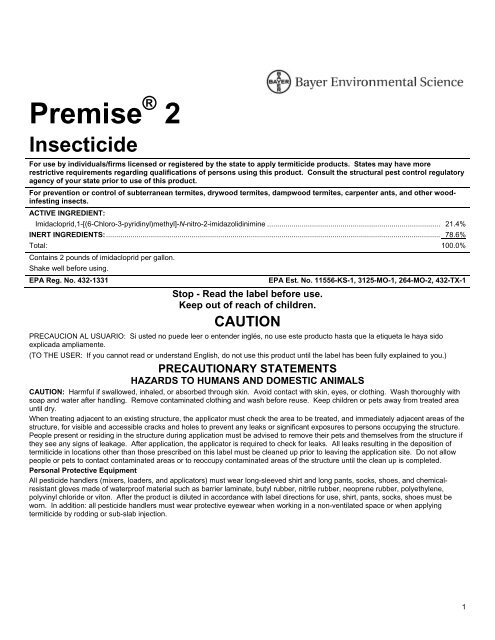

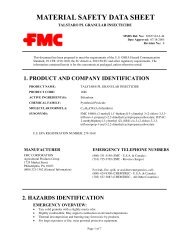
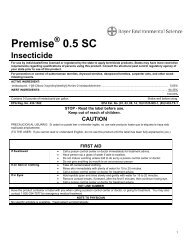
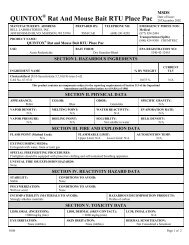
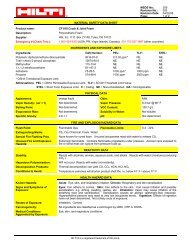
![master msds [msds] - Label](https://img.yumpu.com/41775487/1/190x245/master-msds-msds-label.jpg?quality=85)

